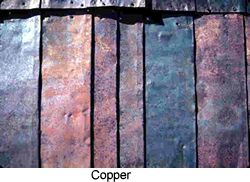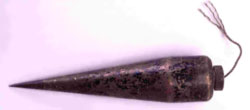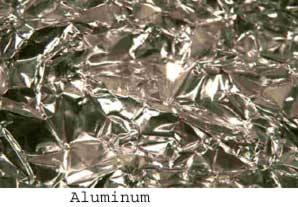BACKGROUND:
 In our everyday world, we are see and
use "elements" in many ways. Advertisements talk about, "Iron
is needed for our blood" or "Silicon Valley." Unfortunately,
not all references to elements are scientifically accurate. For instance,
lead in a pencil is not the element lead, but the mineral graphite which is
composed of the element carbon. A five cent nickel only has a small
percentage of the metal nickel in it. The calcium in milk is not the element
calcium,
just a small percentage of calcium is contained in the chemical composition.
Elemental calcium is a silver white metal and is very reactive. In our everyday world, we are see and
use "elements" in many ways. Advertisements talk about, "Iron
is needed for our blood" or "Silicon Valley." Unfortunately,
not all references to elements are scientifically accurate. For instance,
lead in a pencil is not the element lead, but the mineral graphite which is
composed of the element carbon. A five cent nickel only has a small
percentage of the metal nickel in it. The calcium in milk is not the element
calcium,
just a small percentage of calcium is contained in the chemical composition.
Elemental calcium is a silver white metal and is very reactive.
The elements are grouped into units
that have similar properties. For example elements 2,10,18,36,54, and 86 are
classified as "rare or inert gases." Notice also that the colors
on the periodic table refer to groups of elements that have similar
characteristics. If an element is found naturally not in combination with
other elements it is called a native element or native mineral.
Most of the "elements" that
we are exposed to in advertising are really combinations of elements
(compounds). In this exercise the students will learn the characteristics of
certain elements. Please note that some of the items may not be 100% pure,
but they still exhibit to students the characteristics of that element in
its pure state.
PROCEDURE:
 Tell the
students that today they will be looking at some of the elements found
on the Periodic Table. These elements are either found in nature or
manufactured (silicon). As they look at the samples tell them that they
will need to use words to describe them. Tell the
students that today they will be looking at some of the elements found
on the Periodic Table. These elements are either found in nature or
manufactured (silicon). As they look at the samples tell them that they
will need to use words to describe them.
- Practice words that describe something (color, texture, etc.).
- Pass out the student lab sheets. As students look at the samples and
try to find both the atomic symbol and the atomic number of the element
using the periodic table. They will learn in later grades that the
atomic numbers refer to the number of protons the element possesses. Ask
them to record this information in the appropriate boxes on the lab
sheet.
 After they complete this, ask them to describe the minerals in
descriptive words. Record these in the box on their lab sheet. After they complete this, ask them to describe the minerals in
descriptive words. Record these in the box on their lab sheet.
- As they finish up, orally read the conclusion question. Tell them that
the work 'characteristics' in this case means how it looks and feels.
Elicit responses as to what the students think might be the answer. Then
ask them to write down their response.
- Go over some of the properties of each of the elements found in the
lab. You may want to help the students develop a descriptive vocabulary
before they begin the lab. Below are some accurate descriptions of the
lab specimens.
COPPER - copper color, used to make pipes, teapots, etc (native
mineral)
NICKEL - gray color, used to make nickels and metal, naturally
magnetic
LEAD - gray color, used to make metals, flexible, heavy
SILICON - white or gray color, used in computer industry to make
computer chips
CARBON - gray color, used in making pencils, rubs off easily
SULFUR - yellow color, used in making medicine, (native mineral)
ALUMINUM - gray color, used to make aluminum foil and other metals
IRON - gray color, used in the steel industry, and has other uses as
a metal
ZINC - gray color, used as metal
TIN - gray color, shiny, bends, used as a metal
|